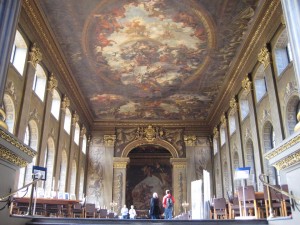A LITTLE MORE ESSENCE
(Scene – present time – sitting at a chair the blogger works into the wee hours of the morning)
After enjoying some two weeks away on expedition to London, England and Malta I can at long last put fingers to the keyboard and punch out a few lines about recent adventures. I like to travel, it’s reminiscent of times spent living overseas and the ability, with today’s wanderings, to remind myself that these places of memory are worthy of reflection. It reminds me to pause, to think, to remember, and to attempt to find the images, the words that capture the essence of these places. It is the combination of the present, and the knowledge of what has gone on before, that I attempt to capture. It brings us to a recent visit to Greenwich, England.
It is here that we find one of the many grand buildings of the former Royal Naval College (1873 – 1998) and formerly the Royal Hospital for Seaman at Greenwich (1694 – 1869). The Painted Hall is a marvel to witness at this amazing world class site designed by Christopher Wren. Like all sites of memory it is interesting to ponder, and in this instance ask, “What salty souls have passed through these doors and corridors?” Who has wandered these grounds and gazed upon the river? How many have thought back to the time of the Tudors, the English Civil War or perhaps the Blitz?
It is at the Painted Hall that I recall my first visit here with my good friend, Mr. John Tamplin MBE TD. What a place! John, with his wonderful way of bringing these buildings to life with the way things once were. In passing he also mentioned that the Hall was often featured in film. It was a grand day out and after all these years I still wonder what camera lenses passed across these fields, cast their gaze upon the river and refocused upon one of the many fine buildings here? Some answers were to follow.
(Scene – a few years before – a living room at home – a couple gathered in their favorite chairs for a Friday night movie)
As we slide the DVD of The Four Feathers into the machine and pressed a menagerie of buttons to make the whole engineering marvel work, I recall the first time I saw this film starring Heath Ledger. I instantly compared it to an earlier version by Alexander Korda, but the comparisons have now faded as I find myself watching this film not too infrequently. The Royal Cumbrians in scarlet tunics, sit within the great Painted Hall at Greenwich where they learn that the regiment will be sent to the Sudan.
(Scene – March 2011 – standing in the Painted Hall – a couple armed with cameras – eyes to the ceiling and walls)
All the while I am taking notes, taking pictures, seeking, searching for something to take into my being. We have chatted about my earlier visit with John, and the room filled with Royal Cumbrians from The Four Feathers and still I yearn for one more thing.
We wander out of the Hall and enter the Chapel where several are already taking in the site. I remain briefly and allow the others to wander within. I turn, and start to walk down the stairs. As I descend I see the four statues just inside the entrance – I had simply walked past earlier (a reminder again to pause, to take time). It is here I find that one thing I am looking for, the quote that sums up the film at the beginning of the show, the words that capture the day. Upon one of these statues a phrase not unfamiliar to some but for me a little more essence, “Faith is the substance of things hoped for. The evidence of things not seen”.
…to be continued


Comments